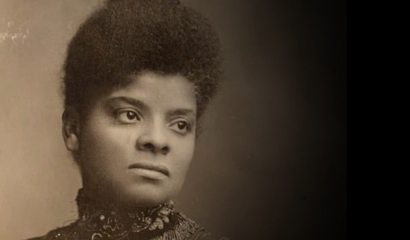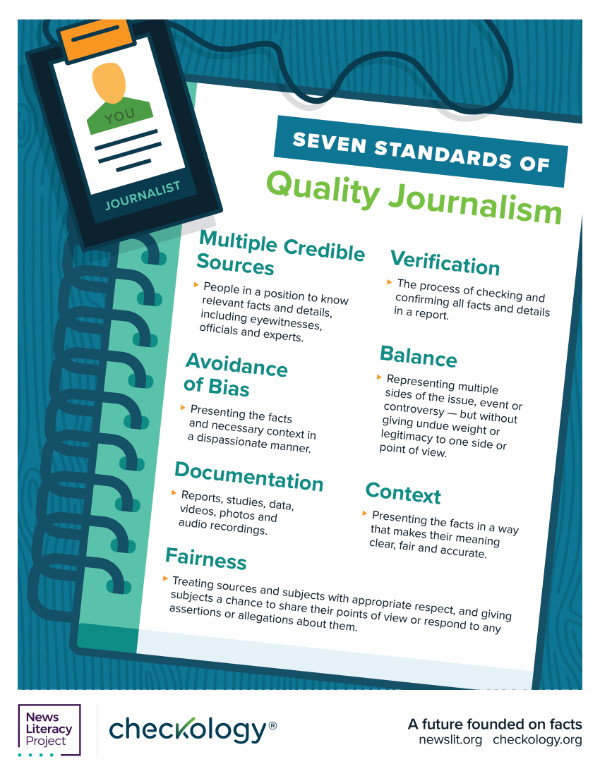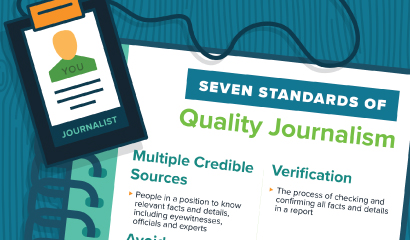News Goggles: Emilie Munson, Times Union
It’s easy to feel overwhelmed by news coverage during an election season. With so many sources competing for attention, how can we know what to trust? Professional journalism standards are one important sign of credibility. Reputable news organizations aspire to ethical guidelines and standards, including fairness, accuracy and independence.
This week, we talk to data reporter Emilie Munson of the Times Union, a local news organization based in Albany, New York, with a coverage area that includes the state’s Capital Region and Hudson Valley. Munson sheds light on the Times Union’s decision to publish a guide explaining how the news organization covers elections and politics — and the role of journalism standards in its news decisions. We also discuss the Times Union’s strict policies on the use of anonymous or unnamed sources. Grab your news goggles!
Note: Look for this newsletter feature the first Monday of the month. You can explore previous News Goggles videos, annotations and activities in NLP’s Resource Library under “Classroom Activities.”
Resources:
- “Practicing Quality Journalism” and “Understanding Bias” (NLP’s Checkology® virtual classroom).
- Infographic: “Is it legit? Five steps for vetting a news source” (NLP’s Resource Library).
Dig deeper: Use this viewing guide for the featured News Goggles video as students consider the role of journalism standards in covering elections and politics.
News Goggles annotations and activities provide news literacy takeaways on timely topics. These resources feature examples of actual news coverage, including full news reports, headlines, breaking news alerts or excerpts.
This video originally appeared in the Nov. 7, 2022, issue of The Sift® newsletter for educators, which explores timely examples of misinformation, addresses journalism and press freedom topics and examines social media trends and issues. Read archives of the newsletter and subscribe here. Stock music in this video was provided by SoundKit from Pond5.
Have feedback about this resource? Or an idea for a future News Goggles? Please share it with us at [email protected].
News Goggles: Conflicts of interest in news reports
News Goggles annotations and activities offer news literacy takeaways on timely topics. These resources feature examples of actual news coverage, including full news reports, headlines, breaking news alerts or excerpts.
This News Goggles resource originally appeared in a previous issue of The Sift newsletter for educators, which explores timely examples of misinformation, addresses journalism and press freedom topics and examines social media trends and issues. Read archives of the newsletter and subscribe here.
A foundational principle of quality journalism is to avoid conflicts of interest – or even the appearance of such conflicts. A conflict of interest is anything that could impact the fairness, accuracy or independence of work produced by a journalist or news organization. Failing to disclose such conflicts, be transparent about them and factor them into news decisions can erode public trust and damage a news organization’s credibility.
In this edition of News Goggles, let’s turn our attention to this key journalism standard by analyzing a March 2, 2021, news report from the Democrat and Chronicle in Rochester, New York, on the controversy over CNN host Chris Cuomo’s coverage of his brother, New York Gov. Andrew Cuomo. Grab your news goggles. Let’s go!
★ Featured News Goggles resource: These classroom-ready slides offer annotations and discussion questions related to this topic.
Note: New York Times opinion columnist David Brooks also faced scrutiny following a BuzzFeed News report about his failure to disclose to readers relevant funding ties to a project he founded outside the newsroom and has written about in his columns. The Times reported on March 6, 2021, that disclosures detailing Brooks’ affiliation with the initiative and his resignation from this outside paid position will be added to columns that reference the project.
Related:
- “Opinion: CNN’s Chris Cuomo is reminding us why conflicts of interest poison the news” (Erik Wemple, The Washington Post).
- “Oh, So Now Chris Cuomo Can’t Cover His Brother For CNN” (Charlotte Klein, Vanity Fair).
- “David Brooks of New York Times criticized for undisclosed financial ties to project he praised” (Paul Farhi, The Washington Post).
Discuss: Why do standards-based newsrooms take conflicts of interest seriously? What are some possible conflicts of interest newsrooms and journalists face? How should news organizations handle potential conflicts of interest?
Have feedback about this resource? Or an idea for a future News Goggles? Please share it with us at [email protected]. You can also use this guide for a full list of News Goggles from the 2020-21 school year for easy reference.
News Goggles: ‘Could not be reached for comment’: Fairness and balance in the Missouri Independent
News Goggles annotations and activities offer news literacy takeaways on timely topics. These resources feature examples of actual news coverage, including full news reports, headlines, breaking news alerts or excerpts.
This News Goggles resource originally appeared in a previous issue of The Sift newsletter for educators, which explores timely examples of misinformation, addresses journalism and press freedom topics and examines social media trends and issues. Read archives of the newsletter and subscribe here.
Fairness and balance are key standards of quality journalism. Being fair includes reaching out to main sources or subjects in news coverage to allow them to share their points of view and respond to any claims or allegations. Balance is representing all relevant sides of an issue without giving one side undue weight or legitimacy.
In this edition of News Goggles, let’s consider fairness and balance as we examine a Dec. 3, 2020, news article (PDF here) about a jail closure in Missouri following a COVID-19 outbreak, as reported by the nonprofit news organization the Missouri Independent. What does it mean if someone “could not be reached for comment”? How do journalists report stories when a key source is unavailable or unwilling to share their perspective publicly? Grab your news goggles. Let’s go!
★ Featured News Goggles resource: These classroom-ready slides offer annotations and discussion questions related to this topic.
Discuss: Is this article fair in its reporting? What steps should reporters take to try and reach a source on deadline? How should a journalist handle unsuccessful efforts to contact a source in a story? If journalists had been able to reach local sheriff’s officials, what questions should they have asked? Is this report balanced? Are any relevant perspectives or voices missing? If a key source responds to a reporter after a story is published, what could the journalists do in response?
Related: “Opinion: RNC blasts Politico over Michigan election story” (Erik Wemple, The Washington Post).
Resource: “Practicing Quality Journalism” (NLP’s Checkology® virtual classroom).
Have feedback about this resource? Or an idea for a future News Goggles? Please share it with us at [email protected]. You can also use this guide for a full list of News Goggles from the 2020-21 school year for easy reference.
Democracy’s Watchdog
 In this lesson, students learn about the vital role the First Amendment protections of free speech and a free press play in American democracy using four case studies of notable investigative (or “watchdog”) reporting. This jigsaw-style lesson has students join an “expert” group to focus on one specific case study, then join their “jigsaw” group to share what they learned with their classmates. Jigsaw group members then document the details of each report and reflect on the role the First Amendment played in each of these historic pieces of journalism.
In this lesson, students learn about the vital role the First Amendment protections of free speech and a free press play in American democracy using four case studies of notable investigative (or “watchdog”) reporting. This jigsaw-style lesson has students join an “expert” group to focus on one specific case study, then join their “jigsaw” group to share what they learned with their classmates. Jigsaw group members then document the details of each report and reflect on the role the First Amendment played in each of these historic pieces of journalism.
This lesson makes the following essential questions available:
- What five freedoms are protected by the First Amendment?
- How do the five freedoms work together to strengthen American democracy? For example, how do the freedoms of speech and assembly work together?
- In what ways can a free press act like a watchdog on behalf of the public?
- If the press sometimes acts like a watchdog, what is it protecting?
- Who watches the watchdogs?
- In what ways can investigative journalism bring about social or political change?
This news literacy classroom activity is suggested for grades 7-9 and 10-12+.
Key terms:
- First Amendment
- Watchdog role
- Multiple sources
- Eyewitness source
- On-the-record source
- Anonymous source
- Context
- Fairness
- Free speech
Connections with other NLP resources:
- “Democracy’s Watchdog” lesson on NLP’s Checkology® virtual classroom
About classroom lessons:
NLP’s lesson plans cover core news literacy subjects that help provide educators with the resources to design their own units. Many of these lessons have a corresponding version on NLP’s e-learning platform, Checkology. You can find activities, quizzes, infographics and posters that complement many lessons in NLP’s resource library.
News Goggles: ProPublica investigation
News Goggles annotations and activities offer news literacy takeaways on timely topics. These resources feature examples of actual news coverage, including full news reports, headlines, breaking news alerts or excerpts.
This News Goggles resource originally appeared in a previous issue of The Sift newsletter for educators, which explores timely examples of misinformation, addresses journalism and press freedom topics and examines social media trends and issues. Read archives of the newsletter and subscribe here.
Public records often serve as the basis for investigative and watchdog reporting that holds the powerful accountable. Let’s examine how records obtained by ProPublica under public information laws shaped a Sept. 14, 2020, investigation by the nonprofit news organization. This story spotlights concerns about COVID-19 outbreaks in meatpacking plants, focusing on emails that highlight “the meat industry’s influence and access to” government officials. ProPublica’s findings offer an example of the watchdog role journalists play in a democracy.
We’ll take a closer look at the use of records alongside elements of fairness and transparency in the newsgathering process. Grab your news goggles! Let’s go!
★ Featured News Goggles resources: Download our full annotations of the ProPublica report in Microsoft Word or as a PDF. Also, these classroom-ready slides pinpoint the big takeaways for a discussion with students.
Related: A Washington Post report first published on Sept. 17, 2020, also made use of documents obtained through a public records request. Read the beginning of this story, which focuses on the U.S. Postal Service’s operations during the pandemic. How does this use of public records compare to ProPublica’s investigation? Were the records obtained in the same way?
Idea: In the United States, teach students about the Freedom of Information Act (FOIA). Then show them how to file a FOIA request for a piece of public information about a topic that affects them or their communities (such as school budgets). For local and state records, try using the letter generator from the Student Press Law Center. For federal FOIA requests, the Reporters Committee for Freedom of the Press offers some helpful guidance.
Resource: “Democracy’s Watchdog” (NLP’s Checkology® virtual classroom).
Have feedback about this resource? Or an idea for a future News Goggles? Please share it with us at [email protected]. You can also use this guide for a full list of News Goggles from the 2020-21 school year for easy reference.
Seven standards of quality journalism

The standards and practices of quality journalism are complex, numerous and dynamic, and are implemented differently by different journalists and different news organizations under different circumstances on different pieces of journalism. See a trend here? Practicing journalism is complicated and nuanced. Still, the general purpose behind the standards is the same: to produce the most accurate, fair and useful information possible.
Some journalism standards are obligatory (such as the prohibition against making things up) and quantifiable (such as newsroom policies about the use of anonymous sources), while others are aspirational (such as the attempt to eliminate bias and to be as fair and accurate as possible) and require judgment and discussion to apply (such as assessing newsworthiness, evaluating sources and determining fairness).
 In almost all cases at major news organizations, these standards are subject to constant reconsideration and revision — whether to prevent the recurrence of an error or to adapt to new tools and methods of gathering and reporting information (for example, using social media to locate sources, or livestreaming breaking news events).
In almost all cases at major news organizations, these standards are subject to constant reconsideration and revision — whether to prevent the recurrence of an error or to adapt to new tools and methods of gathering and reporting information (for example, using social media to locate sources, or livestreaming breaking news events).
By introducing students to the major standards of quality journalism, and helping them understand their nature and rationale, you’re providing them with conceptual and analytical tools that they can use to evaluate the credibility of the information they encounter daily and, in some cases, to critically respond to it. This knowledge can also activate a wide variety of high-level news literacy discussions in your classroom and beyond.
The seven primary standards of quality journalism and their descriptions are included in the poster linked below. This poster is adapted from a highly interactive, immersive learning experience in our Checkology® virtual classroom in which students are placed in the role of a rookie reporter on the scene of a breaking news event and learn the standards of quality journalism by “covering” the story. They are guided by their editor and a veteran reporter back in the newsroom throughout the process, and can use their virtual notebooks to see their progress in following the standards. At the end of the lesson, they build the story, selecting the most appropriate headline, lead, image and more. Use this poster with the Checkology lesson “Practicing the Standards of Quality Journalism” or on its own.